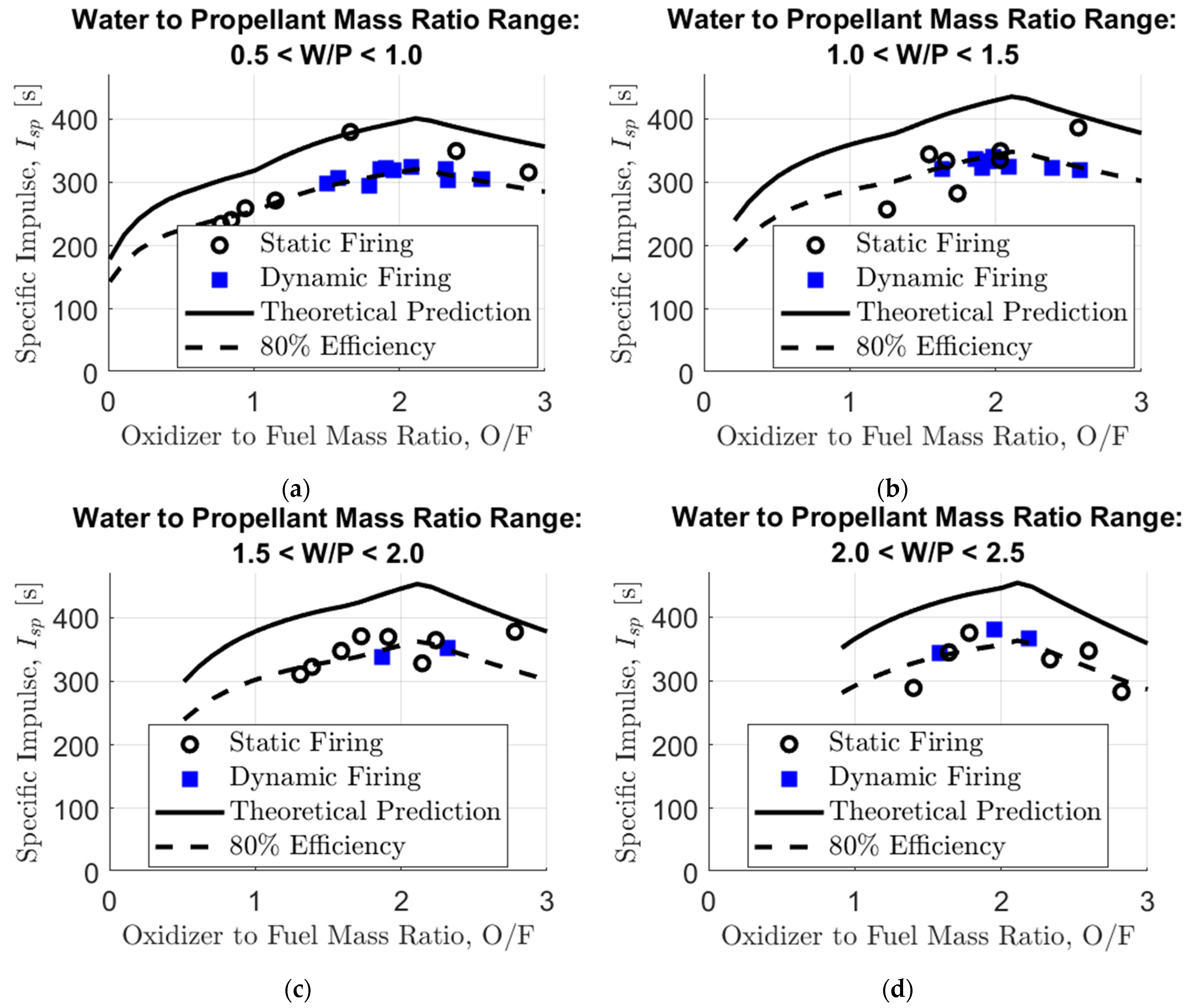Dynamic Testing of a Hybrid-Propellant Water-Breathing Ram Rocket in Underwater Cruise Conditions
Abstract
:1. Introduction
2. Methods
2.1. Theoretical Evaluation
2.2. Experimental Evaluation
2.2.1. Water Basin
2.2.2. Marine Ramjet (Ram Rocket)
3. Results and Discussion
3.1. Theoretical Prediction
3.2. Experimental Results
3.2.1. Single Typical Experiment
3.2.2. Standard Specific Impulse
3.2.3. Pressure Improvement
4. Conclusions
Author Contributions
Funding
Institutional Review Board Statement
Informed Consent Statement
Data Availability Statement
Acknowledgments
Conflicts of Interest
References
- Kirby, G. A History of the Torpedo. J. R. Nav. Sci. Serv. 1972, 27, 30–42. [Google Scholar]
- Moon, H.; Han, S.; You, Y.; Kwon, M. Hybrid Rocket Underwater Propulsion: A Preliminary Assessment. Aerospace 2019, 6, 28. [Google Scholar] [CrossRef]
- Gany, A. Innovative Concepts for High-Speed Underwater Propulsion. Int. J. Energ. Mater. Chem. Propuls. (IJEMCP) 2018, 17, 83–109. [Google Scholar] [CrossRef]
- Yang, Y.J.; He, M.G. A Theoretical Investigation of Thermodynamic Performance for a Ramjet Based on a Magnesium-Water Reaction. J. Eng. Marit. Environ. 2010, 224, 61–72. [Google Scholar] [CrossRef]
- Yang, Y.J.; He, M.G. Thermodynamic Cycle Analysis of Ramjet Engines Using Magnesium-Based Fuel. Aerosp. Sci. Technol. 2012, 22, 75–84. [Google Scholar] [CrossRef]
- Yang, Y.; He, M. Numerical Study on Operating Characteristics of a Magnesium-Based Fuel Ramjet. Acta Astronaut. 2012, 79, 96–106. [Google Scholar] [CrossRef]
- Ghassemi, H.; Fasih, H.F. Propulsive Characteristics of Metal Fuel-Rich Pyrotechnics in Hydro-Reactive Motors. Aerosp. Sci. Technol. 2013, 28, 1–8. [Google Scholar] [CrossRef]
- Liu, D.; Li, S.; Xie, G. Effect of Primary Water Injection Angle on Thermal Propulsion Performance of a Water Ramjet Engine. Aerosp. Sci. Technol. 2020, 97, 2–15. [Google Scholar] [CrossRef]
- Huang, H.T.; Zou, M.S.; Guo, X.Y.; Yang, R.J.; Zhang, P. Analysis of the Solid Combustion Products of a Mg-Based Fuel-Rich Propellant Used for Water Ramjet Engines. Propellants Explos. Pyrotech. 2012, 37, 407–412. [Google Scholar] [CrossRef]
- Huang, H.T.; Zou, M.S.; Guo, X.Y.; Yang, R.J.; Li, Y.K. Analysis of the Aluminum Reaction Efficiency in a Hydro-Reactive Fuel Propellant Used for a Water Ramjet. Combust. Explos. Shock Waves 2013, 49, 541–547. [Google Scholar] [CrossRef]
- Huang, H.T.; Zou, M.S.; Guo, X.Y.; Yang, R.J.; Li, Y.K.; Jiang, E.Z.; Li, Z.S. Study of Different Al/Mg Powders in Hydroreactive Fuel Propellant Used for Water Ramjet. J. Energ. Mater. 2014, 32, 83–93. [Google Scholar] [CrossRef]
- Hu, J.; Han, C.; Xia, Z.; Huang, L.; Huang, X. Experimental Investigation on Combustion of High-Metal Magnesium-Based Hydroreactive Fuels. J. Propuls. Power 2013, 29, 692–698. [Google Scholar] [CrossRef]
- Ramakrishnan, M.; Chakravarthy, S.R.; Ganesan, S.; Jayaraman, K. Effect of Aluminum Particle Size on Primary Combustion and Performance of Water Ramjet. In Proceedings of the AIAA Propulsion and Energy Forum, AIAA Paper 2018-4959, Cincinnati, OH, USA, 9–11 July 2018. [Google Scholar] [CrossRef]
- Ramakrishnan, M.; Chakravarthy, S.R.; Kandasamy, J.; Sarathi, R. Development of Nano-Al Based Highly Metalized Fuel-Rich Propellant for Water Ramjet Propulsion Applications. Propellants Explos. Pyrotech. 2020, 45, 1026–1040. [Google Scholar] [CrossRef]
- Huang, L.; Xia, Z.; Hu, J.; Zhu, Q. Performance Study of a Water Ramjet Engine. Sci. China Technol. Sci. 2011, 54, 877–882. [Google Scholar] [CrossRef]
- Hu, F.; Zhang, W.; Xiang, M.; Huang, L. Experiment of Water Injection for a Metal/Water Reaction Fuel Ramjet. J. Propuls. Power 2013, 29, 686–691. [Google Scholar] [CrossRef]
- Ghassemi, H.; Farshi, F.H. Investigation of Interior Ballistics and Performance Analysis of Hydro-Reactive Motors. Aerosp. Sci. Technol. 2015, 41, 99–105. [Google Scholar] [CrossRef]
- Ramakrishnan, M.; Chakravarthy, S.R.; Kandasamy, J.; Sarathi, R. Experimental Investigation on Aluminum-Based Water Ramjet for Propelling High-Speed Underwater Vehicles. J. Propuls. Power 2023, 39, 886–895. [Google Scholar] [CrossRef]
- Eisen, N.E.; Gany, A. Investigation of a Marine Water-Breathing Hybrid Ram-Rocket Motor. J. Propuls. Power 2022, 38, 370–377. [Google Scholar] [CrossRef]
- Eisen, N.E.; Gany, A. Novel Testing of a Water-Breathing Naval Ramjet at Underwater Cruise Conditions. J. Propuls. Power 2022, 39, 242–248. [Google Scholar] [CrossRef]
- Gordon, S.; McBride, B.J. Computer Program for Calculation of Complex Chemical Equilibrium Compositions and Applications; Rept.RP-1311; NASA Lewis Research Center: Cleveland, OH, USA, 1994.












Disclaimer/Publisher’s Note: The statements, opinions and data contained in all publications are solely those of the individual author(s) and contributor(s) and not of MDPI and/or the editor(s). MDPI and/or the editor(s) disclaim responsibility for any injury to people or property resulting from any ideas, methods, instructions or products referred to in the content. |
© 2024 by the authors. Licensee MDPI, Basel, Switzerland. This article is an open access article distributed under the terms and conditions of the Creative Commons Attribution (CC BY) license (https://creativecommons.org/licenses/by/4.0/).
Share and Cite
Dinisman, S.; Eisen, N.E.; Gany, A. Dynamic Testing of a Hybrid-Propellant Water-Breathing Ram Rocket in Underwater Cruise Conditions. J. Mar. Sci. Eng. 2024, 12, 809. https://doi.org/10.3390/jmse12050809
Dinisman S, Eisen NE, Gany A. Dynamic Testing of a Hybrid-Propellant Water-Breathing Ram Rocket in Underwater Cruise Conditions. Journal of Marine Science and Engineering. 2024; 12(5):809. https://doi.org/10.3390/jmse12050809
Chicago/Turabian StyleDinisman, Sagi, Nachum E. Eisen, and Alon Gany. 2024. "Dynamic Testing of a Hybrid-Propellant Water-Breathing Ram Rocket in Underwater Cruise Conditions" Journal of Marine Science and Engineering 12, no. 5: 809. https://doi.org/10.3390/jmse12050809




